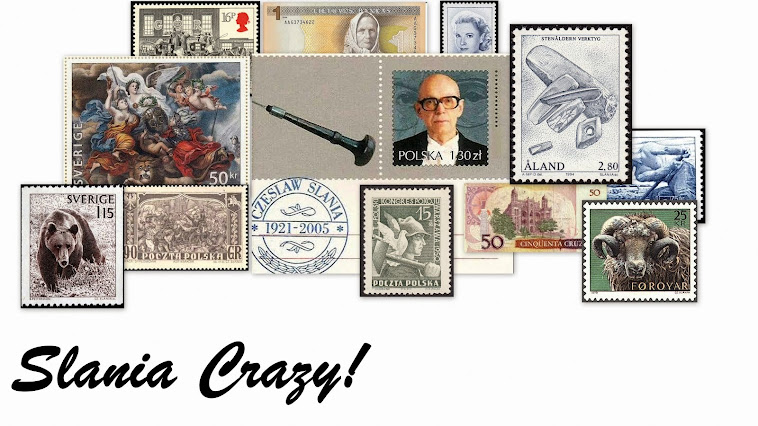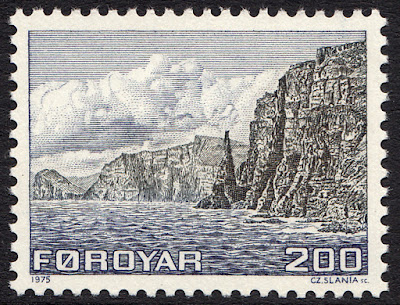Slania Crazy has just surpassed 10,000 page views. I am absolutely thrilled! A big thank you to everyone out there who takes the time to read my ramblings. In order to celebrate this milestone I'd thought it would be fun to feature Czelsaw Slania's 1,000th engraving, which also happens to be the largest engraved stamp in the world.
The stamp was issued in Sweden on 17 March 2000 in Souvenir Sheet format. It is based on a painting by David Klöcker Ehrenstråhle, titled The Great Deeds of the Swedish Kings. I'll get back to the painting in a bit, but for now let us feast our eyes on the truly sumptuous work of Czeslaw Slania. The stamp is absolutely massive and the detail amazing.
The subject of this stamp is a portion of a ceiling fresco made by David Klöcker Ehrenstråhle in 1695 in Drottningholm Palace, the home of the Swedish Royal Family. The palace fresco is actually a copy of an earlier work by David Klöcker Ehrenstråhle located on the ceiling of the Great Hall of the House of Knights, made between 1670 and 1675. The painting depicts the allegorical figure, Eterna (Eternity) holding the Crown of Immortality. Below is a rather blurry image of the painting detailing the section Slania chose to reproduce in his engraving.
At the top left of the painting is Eterna with the Crown of Immortality depicted as a crown of stars. As you can see, this falls outside of the section engraved by Slania.
The part of the painting Slania chose is packed with detail and certainly worthy of a couple of close-ups. At the bottom of the stamp is a lion bounding through the heavens. Lions have been associated with Swedish heraldry for centuries. I must say, though, that this lion seems a tad frightened.
Dominating the stamp is a beautiful angelic figure, perhaps guiding those below her towards the heavens. In the painting, it seems the angelic figure is guiding those with her up to Eternity, but since Eternity doesn't feature in the stamp, I figure the heavens is the suggestion.
Since the detail work on this stamp is so stunning, I thought I'd include some different stages of the die plate.
Just one final titbit of information before I call it quits. The building featured at the bottom of the Souvenir Sheet is Drottningholm Palace, the home of the fresco. Interestingly, Piotr Naszarkowski, who can be considered Slania's successor, engraved a stamp for Sweden in 1991 of that very building.
Until next time...
Stay Slania Crazy!
The stamp was issued in Sweden on 17 March 2000 in Souvenir Sheet format. It is based on a painting by David Klöcker Ehrenstråhle, titled The Great Deeds of the Swedish Kings. I'll get back to the painting in a bit, but for now let us feast our eyes on the truly sumptuous work of Czeslaw Slania. The stamp is absolutely massive and the detail amazing.
***
The subject of this stamp is a portion of a ceiling fresco made by David Klöcker Ehrenstråhle in 1695 in Drottningholm Palace, the home of the Swedish Royal Family. The palace fresco is actually a copy of an earlier work by David Klöcker Ehrenstråhle located on the ceiling of the Great Hall of the House of Knights, made between 1670 and 1675. The painting depicts the allegorical figure, Eterna (Eternity) holding the Crown of Immortality. Below is a rather blurry image of the painting detailing the section Slania chose to reproduce in his engraving.
At the top left of the painting is Eterna with the Crown of Immortality depicted as a crown of stars. As you can see, this falls outside of the section engraved by Slania.
***
The part of the painting Slania chose is packed with detail and certainly worthy of a couple of close-ups. At the bottom of the stamp is a lion bounding through the heavens. Lions have been associated with Swedish heraldry for centuries. I must say, though, that this lion seems a tad frightened.
***
***
Since the detail work on this stamp is so stunning, I thought I'd include some different stages of the die plate.
***
Just one final titbit of information before I call it quits. The building featured at the bottom of the Souvenir Sheet is Drottningholm Palace, the home of the fresco. Interestingly, Piotr Naszarkowski, who can be considered Slania's successor, engraved a stamp for Sweden in 1991 of that very building.
Until next time...
Stay Slania Crazy!






















